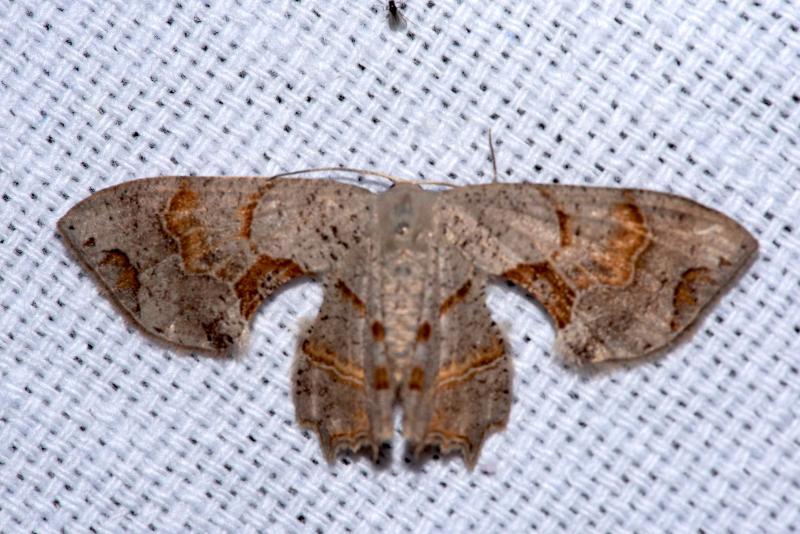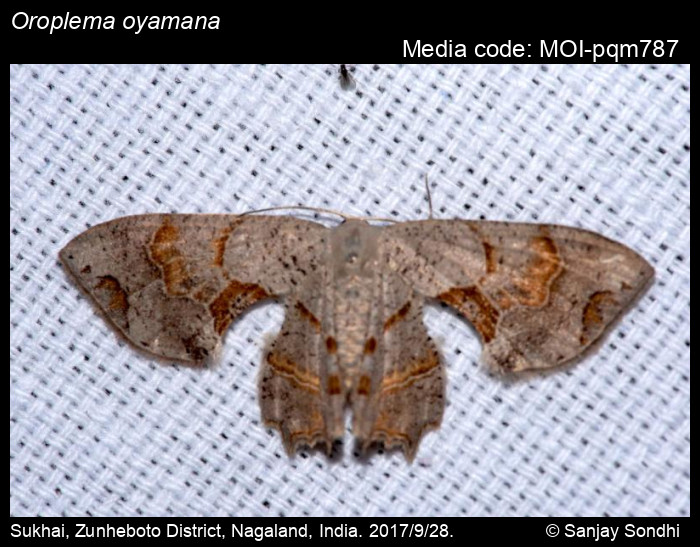Image

Life stage
Email (of contributor)
sanjay.sondhi1@gmail.com
Notes (optional)
Proposed ID: Oroplema oyamana (Matsumura, 1931)
Epiplema oyamana Matsumura, 1931, 6000 Insects Japan-Empire, p. 942.
Epiplema dealbata Warren, sensu Holloway, 1976: 683.
Epiplema simplex Warren, sensu Inoue, 1983, Moths of Japan, 2: 311 (mis-identified).
Sohn, J. C. & Yen, S. H. 2005. A Taxonomic Revision of the Korean Epipleminae (Lepidoptera: Uraniidae), with Phylogenetic Comments on the Involved Genera. Zoological Studies 44(1): 44–70. Pg. 64, Fig. 2Q,R,S.
Moths of Borneo, Vol. 8, pg. 102, pl. 7/21
https://www.mothsofborneo.com/part-8/epipleminae/epipleminae_8_1.php
Based on notes in Sohn & Yen (2005): This species (oyomana) was misidentified as either Oroplema simplex (Warren, 1899) (as Epiplema simplex) or Dysaethria indignaria (Walker, 1866) (as Epiplema indignaria) in the Japanese and Taiwanese literature for a long time. However, the true Oroplema simplex is exclusively distributed in S. India and Sri Lanka. Oroplema simplex can be distinguished from oyamana by having a narrower dark patch at the forewing hind margin and a straighter antemedial line of the hindwing.
Misidentified/misapplied:
• Epiplema simplex (= Oroplema oyamana); Inoue, 1983, Moths of Japan 2: 311
JD : agree this looks like & matches the description of O. oyamana. But so does my image in Observation_283223 from S. India! Sohn & Yen state that O. simplex is exclusively distributed in S. India & Sri Lanka. This does not rule out O. oyamana from S. India, though the range is mentioned as N India & NE Himalaya?
SS: Yes, I agree that your observation is not so clear, though it seems more like O. oyamana. Note the shapes of the narrower dark patch at the forewing hind margin are different in this individual and yours from S. India. Perhaps we ahead with this as O. oyamana, and keep your image as Oroplema spp.?
GI: I want to point out a feature which is not mentioned in any of the texts but is evident in the images that we have all uploaded. Do give it a serious thought. Check the images on the Korean paper for the antimedian line in the hw of omayana and simplex. In Omayana it is a broken line where as in simplex its a continous one. This is a feature I see in both mine and Jonathan's uploads as well as Sanjay's upload of simplex. Should that not matter?
moi-pqm 457 uploaded as simplex should either by Omayana or else moved to Oroplema spp. I don't agree it is O simplex.
SS: I examined the point raised by Geetha, and this feature is not consistent. If you look at the simplex image on Korean Epiplema paper, them the ante medial line in simplex is not broken. My view is that that if we you are not convinced, we publish this species as Oroplema oyamana, and make the uncertain ones as spp. Let me know if this is ok.
Epiplema oyamana Matsumura, 1931, 6000 Insects Japan-Empire, p. 942.
Epiplema dealbata Warren, sensu Holloway, 1976: 683.
Epiplema simplex Warren, sensu Inoue, 1983, Moths of Japan, 2: 311 (mis-identified).
Sohn, J. C. & Yen, S. H. 2005. A Taxonomic Revision of the Korean Epipleminae (Lepidoptera: Uraniidae), with Phylogenetic Comments on the Involved Genera. Zoological Studies 44(1): 44–70. Pg. 64, Fig. 2Q,R,S.
Moths of Borneo, Vol. 8, pg. 102, pl. 7/21
https://www.mothsofborneo.com/part-8/epipleminae/epipleminae_8_1.php
Based on notes in Sohn & Yen (2005): This species (oyomana) was misidentified as either Oroplema simplex (Warren, 1899) (as Epiplema simplex) or Dysaethria indignaria (Walker, 1866) (as Epiplema indignaria) in the Japanese and Taiwanese literature for a long time. However, the true Oroplema simplex is exclusively distributed in S. India and Sri Lanka. Oroplema simplex can be distinguished from oyamana by having a narrower dark patch at the forewing hind margin and a straighter antemedial line of the hindwing.
Misidentified/misapplied:
• Epiplema simplex (= Oroplema oyamana); Inoue, 1983, Moths of Japan 2: 311
JD : agree this looks like & matches the description of O. oyamana. But so does my image in Observation_283223 from S. India! Sohn & Yen state that O. simplex is exclusively distributed in S. India & Sri Lanka. This does not rule out O. oyamana from S. India, though the range is mentioned as N India & NE Himalaya?
SS: Yes, I agree that your observation is not so clear, though it seems more like O. oyamana. Note the shapes of the narrower dark patch at the forewing hind margin are different in this individual and yours from S. India. Perhaps we ahead with this as O. oyamana, and keep your image as Oroplema spp.?
GI: I want to point out a feature which is not mentioned in any of the texts but is evident in the images that we have all uploaded. Do give it a serious thought. Check the images on the Korean paper for the antimedian line in the hw of omayana and simplex. In Omayana it is a broken line where as in simplex its a continous one. This is a feature I see in both mine and Jonathan's uploads as well as Sanjay's upload of simplex. Should that not matter?
moi-pqm 457 uploaded as simplex should either by Omayana or else moved to Oroplema spp. I don't agree it is O simplex.
SS: I examined the point raised by Geetha, and this feature is not consistent. If you look at the simplex image on Korean Epiplema paper, them the ante medial line in simplex is not broken. My view is that that if we you are not convinced, we publish this species as Oroplema oyamana, and make the uncertain ones as spp. Let me know if this is ok.
Name for copyright (do not include copyright symbol)
Sanjay Sondhi
HighLighted Contributions
No
Species Node
Overwrite img

Organism
Butterfly
Moth Taxon search:
Month
September
Year
2017
Day
28
Choose copyright license
Copyrighted (all rights reserved)